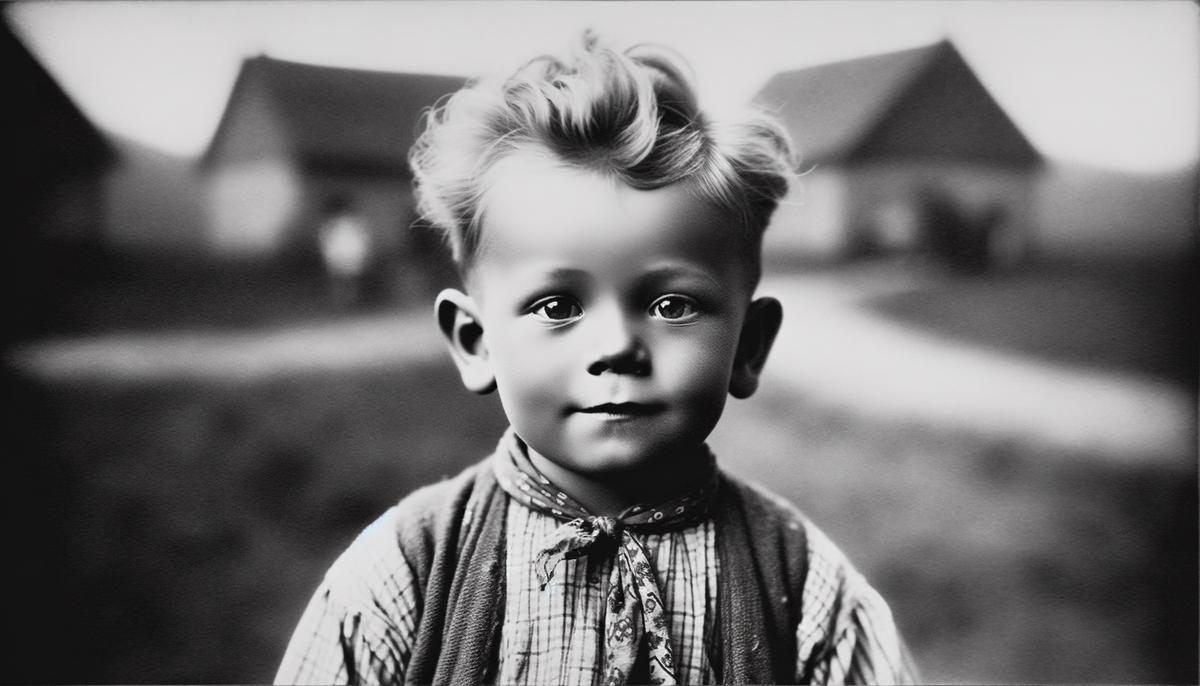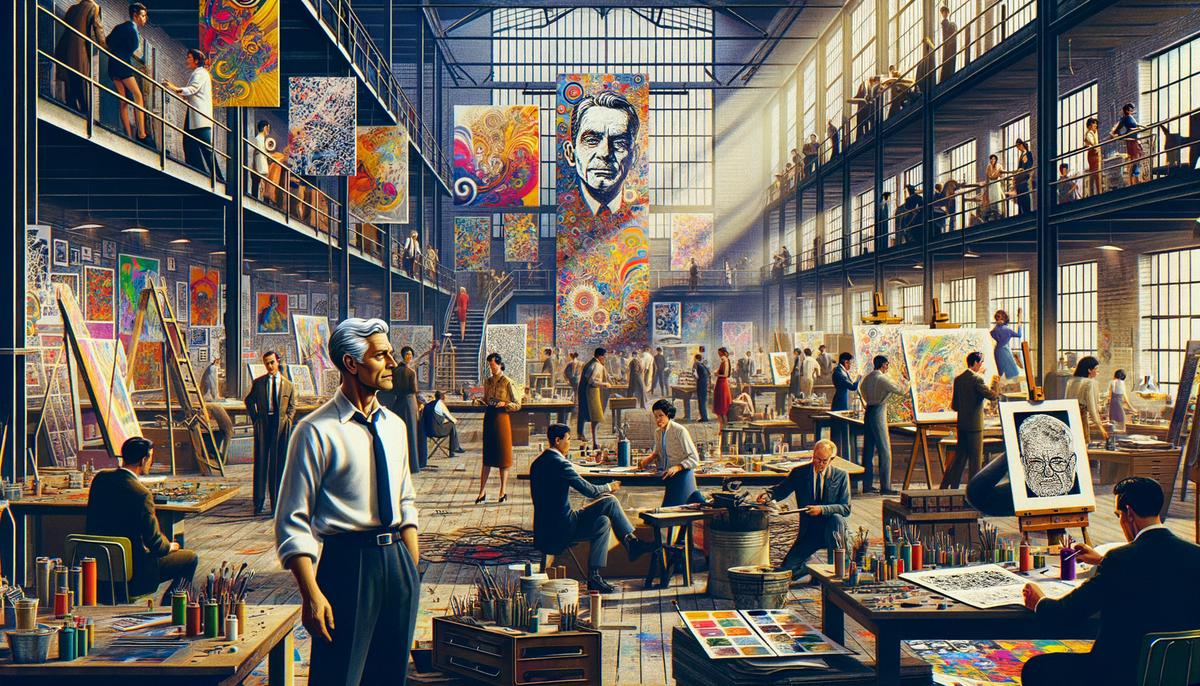Warhol’s Early Life
Andy Warhol, son of Eastern European immigrants, grew up in a working-class neighborhood of Pittsburgh during the Great Depression. His family's humble beginnings played a pivotal role in shaping his art. Warhol's father was a construction worker, and his mother, an embroiderer. They instilled in him the importance of hard work and the value of creativity. Warhol's early encounters with art came through his mother's drawings and his own childhood illness, during which he found solace in collecting pictures of movie stars and drawing.
A significant part of Warhol's background was his struggle with a nervous condition as a child, leading him to be homebound for long stretches. This isolation fueled his imagination and deepened his interest in the pop culture that surrounded him. Warhol's fascination with the glitz and glam of Hollywood became a recurrent theme in his later works.
The family's financial struggles meant that Warhol understood the value of money from an early age. This early insight into the commercial aspect of life influenced his art, making him one of the first artists to fully embrace the art-commerce dichotomy, later evident in his famous Campbell's Soup Cans and celebrity portraits.
Warhol's education at the Carnegie Institute of Technology, now Carnegie Mellon University, where he studied pictorial design, underscored his belief in the functional aspect of art. It was here that he honed his skills in commercial illustration, a field where he initially made a name for himself in New York. The city offered Warhol the perfect backdrop to merge his artistic talents with commercial ventures. Working as a commercial illustrator for well-known magazines and creating window displays, Warhol's unique style caught the eye of the public and critics alike.
His swift move from commercial illustration to pop art was both a reflection of his mastery over commercial aesthetics and a comment on the burgeoning consumer culture post-World War II America. Warhol's silkscreening technique, borrowed from commercial printing, allowed him to produce art that was both reflective of mass production and critical of it. His choice of subjects, often everyday objects and celebrities, speaks volumes about his upbringing during a time when American consumerism was taking root.
A profound connection with his Slovakian heritage is visible in the somewhat muted expressions of emotional depth in Warhol's works, aligning with the traditionally reserved Slavic disposition. Though seemingly emotionless at first glance, his pieces often carry a deeper commentary on societal norms, celebrity culture, and the very nature of art itself.

Warhol’s Pop Art Revolution
Andy Warhol is indelibly linked to the Pop Art movement, an art movement that emerged in the 1950s and reached its zenith in the 1960s. Warhol, with his profound comprehension of commercial and popular culture, redefined what art could encompass. This exploration seeks to unpack Warhol's monumental contributions to Pop Art through his visionary use of commercial goods, celebrity portraits, and innovative techniques that contested traditional art norms and mirrored the burgeoning consumer society.
Warhol's ingenuity first garnered widespread acclaim with his groundbreaking series of Campbell's Soup Cans paintings in 1962. This remarkable body of work epitomizes Warhol's fascination with mass-produced goods and their role within American life. By isolating and repeating the banal image of a soup can across 32 canvases—one for each variety offered by Campbell's at the time—Warhol underscored the pervasiveness of consumerism in everyday life. These striking pieces pose a variety of interpretations; are they mere representations, critiques, or celebrations of consumer culture?
Another cornerstone in Warhol's contribution to Pop Art lies in his Marilyn Diptych (1962). Following Marilyn Monroe's untimely death, Warhol utilized a publicity photo to create this iconic piece. The work comprises 50 silkscreened images of Monroe—half brightly colored, half in stark black and white. Reflecting on this duality, the piece contemplates Monroe's public persona versus her private anguish, the impermanence of fame, and the commodification of celebrities—themes central to both Warhol's oeuvre and Pop Art more broadly.
Central to Warhol's legendary status within the art world was his adoption and refinement of the silkscreening technique. This method enabled him to reproduce images rapidly and on a large scale, mirroring the mass production methods that were a hallmark of consumer society. Warhol once articulated his affection for the silk-screening process by lauding its ability to let him "get away from himself," finding solace in the machine-like consistency that it provided.1 This approach not only demystified the art-making process but also dismissed the elitist conception of the artist as a solitary genius, aligning instead with Warhol's view of art as a collective and accessible venture.
Through pieces like his Campbell's Soup Cans and Marilyn Diptych, amongst others, Warhol relentlessly prodded at the boundaries separating high art from low culture, thereby democratizing art for a broader audience. His works became conduits for conversation around identity, celebrity culture, consumerism, and visual culture.
Moreover, Warhol's Factory—an art studio that served as a vibrant cultural hub in New York—further cemented his legacy as a Pop Art titan. The Factory was not merely a physical space but a breeding ground for ideas that defined an era's zeitgeist. It provided Warhol with the environment to collaborate extensively, cultivating a multimedia portfolio that included not just paintings and silkscreens but also film, music, and multimedia installations.
Warhol's insatiable curiosity for popular culture, coupled with his innovative artistic methods, boldly challenged traditional notions of art while epitomizing the spirit of the Pop Art movement. His remarkable ability to intersect art with consumerism, coupled with his astute observations of celebrity culture, solidified his place as a cornerstone of twentieth-century art. Through his work, Warhol demonstrated that ordinary objects and familiar faces could be transformed into high art, thereby changing the course of art history.

Warhol’s Legacy and Influence
Andy Warhol not only marked an epoch with his unique vision but also laid the groundwork for a cultural shift that continues to influence contemporary art and popular culture. His pioneering efforts in merging high art with commercial imagery catalyzed a new understanding and manipulation of visual culture which is palpable in today's digital, image-saturated world. This segment endeavors to explicate the multifaceted impact of Warhol's artistry on contemporary mediums and societal themes.
Warhol's experimental approach, particularly his sedulous application of silkscreen printing, has inspired countless artists to explore commercial and digital techniques within their practices. The essence of Warhol's art—highlighted by his aptitude for replication and mass production—resonates in the ethos of movements like Postmodernism, where appropriation and pastiche become modes of both homage and critique. Artists such as Damien Hirst and Jeff Koons have emulated Warhol's fascination with commodity culture, creating works that interrogate the nexus between art, consumer value, and authenticity.
Digital artists today continue to draw upon Warhol's technological curiosity by leveraging algorithms and digital platforms to replicate the seriality and democratic ethos found in Warhol's oeuvre. In this sense, Warhol anticipated the digital age's velocity and voracity for image production and consumption, forging paths for art forms that exploit the aesthetic of mass media, such as meme culture and digital illustration.
Beyond the canvas, Warhol's conceptual legacy spans far and wide into the social fabric, especially in our comprehension of fame and persona in the digital age. Warhol famously predicted the transient nature of celebrity with his prescient assertion that "in the future, everyone will be world-famous for 15 minutes."2 This anticipated the current era of social media, where Internet virality offers fleeting glimpses of fame to virtually anyone. In today's world of influencers and vloggers, Warhol's exploration of the manufacture of celebrity and the artifice of public image seems not just innovative but prophetic.
Warhol's work continues to interrogate the relationship between art and commerce. His unabashed embrace of commercialism serves as a precursor to the integrated marketing strategies that define the contemporary digital marketplace, wherein influencers and artists alike capitalize on their platforms to promote products and ideologies.
Warhol's background and aesthetic choices significantly bolstered the visibility of queer culture within mainstream art and society. Openly exploring themes of identity, desire, and the body, his work—and more broadly, his lifestyle—played a pivotal role in bringing queer perspectives to the forefront of cultural dialogue. This advocacy laid foundational stones in art for subsequent generations to express their nuanced perspectives on queer identity, contributing to the richer tapestry of inclusion we witness in current art scenes.
Andy Warhol's enduring influence is not solely contained within the realm of art; his legacy permeates the very way contemporary society perceives and consumes visual culture. Warhol's ingenuity redefined the intersections amongst art, technology, and everyday life—pioneering a worldview that sees beauty in simulacra and significance in the mundane. As we navigate through the flux of a continuously evolving digital landscape, Warhol's conceptual paradigms serve as both a prophetic mirror and a beacon guiding uncharted creative explorations. By elucidating the iconic nature of everyday objects and the pre-manufactured veneer of celebrity, Warhol didn't just influence art and culture; he fundamentally transformed how we conceive of and interact with the world around us. His legacy is thus both an echo of 20th-century innovation and a harbinger for future cultural discourses—bridging past ideologies with contemporary and emergent narratives in an ever-expanding universe of art.

In essence, Andy Warhol's legacy transcends the confines of the art world, challenging us to perceive our surroundings and the media we consume in new and thought-provoking ways. His ability to transform ordinary objects and familiar faces into high art not only altered the course of art history but also fundamentally changed how we engage with the world around us. Warhol's work remains a testament to the power of art to reflect and shape human experience, ensuring his place as a beacon of cultural discourse in the 20th century and beyond.
- Warhol A, Hackett P. POPism: The Warhol '60s. New York, NY: Harcourt Brace Jovanovich; 1980.
- Warhol A. The Philosophy of Andy Warhol: From A to B and Back Again. New York, NY: Harcourt Brace Jovanovich; 1975.
























